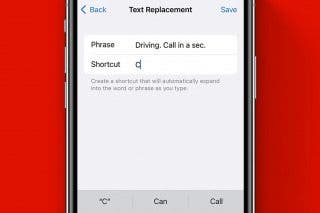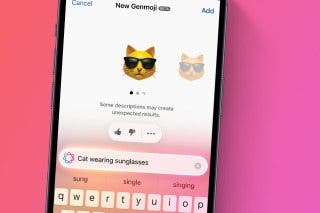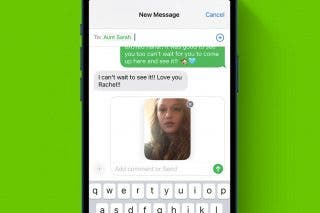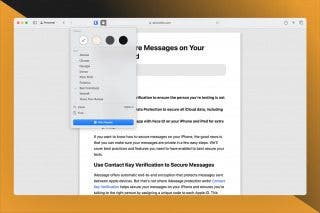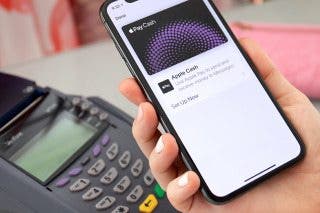How I Built iPhone Life Part 1


In the 116th episode, iPhone Life’s founder Hal Goldstein shares the unlikely story of how a Hewlett Packard software engineer moved to the cornfields of Iowa to start a tech publishing company.
Click here to listen and subscribe. If you like what you hear, be sure to leave a review. And remember to tune in every other week to hear our editors share with you the latest Apple news, best apps, iPhone tricks, and coolest accessories.
This episode is brought to you by Matias. When Apple discontinued its wired keyboard, Matias stepped in to provide a one of equal value and arguably better quality. The Wired Aluminum Keyboard's built-in hub with multiple ports is great for connecting your wired mouse and other devices and the Mac-friendly function keys make it easy to transition. Matias also makes Tenkeyless and RGB keyboards.
Special Discount for Podcast Listeners!
Want more iOS how-to content that's designed to make your life easier and more productive? Visit iPhoneLife.com/PodcastDiscount and get $5 off our premium subscription to iPhone Life Insider.
Question of the week:
How did you learn about iPhone Life? Email podcasts@iphonelife.com and let us know.
Articles referred to in this episode:
Book referred to in this episode:
Useful links:
- Join the iPhone Life Facebook Group
- Insider walk-through: get a sneak peek of members-only benefits
- Get the Insider discount for Podcast Listeners
- Sign up for the free Tip of the Day Newsletter
- Email the Podcast
- Subscribe to iPhone Life magazine
Transcript of episode 116:
Donna Cleveland: Hello, and welcome to iPhone Life podcast. I'm Donna Cleveland, editor-in-chief at iPhone Life.
David Averbach: I'm David Averbach, CEO and publisher.
Donna Cleveland: And today we have a special guest. We have Hal Goldstein. He's the founder of iPhone Life. Thanks for joining us, Hal.
Hal Goldstein: Oh, it's my pleasure. Believe me.
Donna Cleveland: So today we wanted to bring Hal on to tell the story of iPhone Life. He's the author of The Meditating Entrepreneurs. Sorry. Meditating Entrepreneurs-
Hal Goldstein: There it is.
Donna Cleveland: ... How to Create Success From the Stillness Within. And he wrote a book and also worked with many other entrepreneurs to tell the story of the values behind their businesses. He has a chapter dedicated to iPhone Life and the companies that came before iPhone Life, before it evolved into iPhone Life. So we wanted to have him come on and share his story with all of you We'll have a second episode in a couple of weeks where we share how we come into the story, David and I.
David Averbach: Yeah, so this is something a little different. We haven't tried this before. Those of you who have ever listened to how I Built This, we're going to try to imitate that style a little bit because I love that podcast. So this'll be the story of how iPhone Life got started and actually the publisher, because we've been around long before iPhone Life, how that got started as well. It's, like Donna said, two episodes, so if this is your thing then stick around. If you want to skip it for more iPhone related content, we'll be back with our normal content-
Hal Goldstein: No, we're going to be talking about all the-
David Averbach: We'll be talking about iPhone content.
Hal Goldstein: ... all sorts of ... not only iPhones but all the precursors to the iPhone. All those other little devices. The iPhone really wasn't the first.
David Averbach: And we're still going to do our tip of the day and all that.
Donna Cleveland: And part of what's fun about this episode is just reading through this chapter that Hal wrote about the company is that, as you can see, the person behind the company, a lot of what we still do at iPhone Life today and the values that we have here are because of Hal. So, I think that's also similar to how I Built This. You see how a company came to be what it is, and usually, it's the people behind it that made it what it is.
David Averbach: Absolutely.
Donna Cleveland: I think this will be a lot of fun.
Hal Goldstein: One of the things I'm so happy about how the company has evolved since I left full-time is the DNA, the integrity and the values, are as good or ever they've ever been. I'm just real happy with you guys.
David Averbach: We appreciate that.
Donna Cleveland: Glad to hear it.
Donna Cleveland: All right, so let's start off with telling about our sponsor.
David Averbach: Yeah, absolutely. So our sponsor for today is Matias. Matias has a wide range of keyboards, and they work for both the Mac iPad and iPhone. They have Bluetooth keyboards, but today I'm going to tell you about the wired keyboards. Apple has actually stopped making wired keyboards now, so Matias basically took the ball and ran with it. It's an aluminum keyboard just like Apple used to make. They have tenkeyless. They have ones with 10 key. I am all about 10 keys. How about you? Oh, you have a tenkeyless. How are you liking that?
Donna Cleveland: I like it okay. Honestly, it wasn't a choice. With my other keyboard, I spilled water on it, and so I just found one in the office.
David Averbach: Okay. So for those of you who are a little confused, the tenkeyless, that's the numeric keypad. Some have it, some don't. The nice thing is it's even cheaper than Apple used to make it. It's $55 for the tenkeyless, 59 for if you want the 10 keys, for the wired. If you want Bluetooth, you can get that. They have backlit. Really high-quality keyboards. We all have them in the office. We love them, so make sure you check it out. We'll link to it in the show notes at iphonelife.com/podcast.
Donna Cleveland: And I personally really like having a wired keyboard because the battery dying and just connection issues just drives me crazy.
David Averbach: Yeah. I agree.
Donna Cleveland: It's one of those, like certain things I like wireless. For a keyboard, I personally like wires.
David Averbach: I agree, but I will say one of the nice things about Matias', I have a Bluetooth keyboard here, and the battery lasts for a year.
Donna Cleveland: That's amazing.
David Averbach: So, you don't really need to worry about too much, and so that is pretty nice.
Donna Cleveland: Right. Okay. Cool.
Hal Goldstein: One of the neat things is now, you take things like wireless keyboards for granted, but it was such a big deal when they first came in the late '90, early 2000s.
David Averbach: Such a game-changer?
Hal Goldstein: Yeah. Yeah.
Donna Cleveland: Yeah, I guess that's true.
David Averbach: Even the technology behind the Bluetooth. I remember when Bluetooth was just a new emerging technology.
Hal Goldstein: N it was such a pain to connect with Bluetooth.
David Averbach: It never worked. I know. It still is a little bit of a pain.
Hal Goldstein: Yeah. Yeah.
Donna Cleveland: It's a lot better than it used to be but all right. So, we have a couple of things we want to cover before we get into our main theme. Our daily tip for this week is how to share a wi-for instance password with a nearby iPhone. This is a feature that came out last year with iOS 12 that ... Have you guys used this much?
David Averbach: I love this feature. Yeah.
Hal Goldstein: No, but I want to know because, especially in my home, I'd love to do that.
David Averbach: Yeah.
Donna Cleveland: Yeah. So it's really nice if you're visiting somewhere, and a lot of times people have those really long wi-fi passwords because they never changed them. What you can do is, as long as you're both connected to wi-fi and Bluetooth on your devices, if you go to connect to the wi-fi network, the other person who's connected before will get a little popup that says, "Would you like to share your wi-fi password?" You just tap okay, and it will automatically fill on the other person's phone.
Hal Goldstein: Oh, neat.
Donna Cleveland: And they're logged in.
David Averbach: Yeah, so when you're saying you both need to be connected to wi-fi, obviously, this person's trying to connect to wi-fi.
Donna Cleveland: Oh, sorry.
David Averbach: But what you do, is if you go into someone's home, or you're in a coffee shop, or whatever, you go into the settings on wi-fi, and when you pull up the little menu that shows you what to connect, it will pop up on the other person's phone and say, "Do you menu to share?"
Donna Cleveland: Sorry. Yeah, wi-fi enabled.
David Averbach: Oh, okay.
Donna Cleveland: So you'd have your wi-fi on so that you can find the network to try to connect. But, yeah.
David Averbach: My only complaint about this, I'm going to add a bonus complaint since I don't think we're having one this week, is I wish you could preempt it. I wish as the person who has the wi-fi password, I could just send it to the other person because it's a little bit, by the time you go to share it, the person's already trying to connect, and I think a lot of people are already trying to figure out the password by the time they go to connect. It would be nice if I could, as the person who has the wi-fi already, just preempt it and send it to them before they ever reach the wi-fi connecting stage. Does that make sense?
Donna Cleveland: Yeah. That would be nice. But it still, it's a feature I'm glad they added.
David Averbach: Yeah.
Donna Cleveland: Super easy to use.
David Averbach: And it's really nice because it happened to me the other day. We were all in a coffee shop, and I didn't remember the password, but I had connected to it. My phone was connected to it at the time, and so I could share the password with the person who was actually Sarah.
Donna Cleveland: Okay.
David Averbach: I could share the password with Sarah without even knowing the password. It's really useful in that regard as well.
Donna Cleveland: Yeah. So this is part of our Daily Tips newsletter. If you haven't signed up already, you can go to iphonelife.com/dailytips, and this is our free offering that teaches you something cool you can do with your phone in just less than a minute a day. It's really painless, free, which is always great, and it's a great way to get acquainted with our company. So, go to iphonelife.com/dailytips if you haven't signed up already.
Donna Cleveland: I also want to take a moment to tell you about our premium subscription, which is iPhone Life Insider, and that's our full educational service that will help you get the most out of your iOS devices. I highly recommend it. You get a full library of video guides. We have one on the latest versions of iOS, ones on the iPad, Apple Watch, iPhone 10, all of these different things that will really help you get the most out of your devices. You get a full archive of iPhone Life Magazine, and that includes all the full archive of the digital version of iPhone Life Magazine. That means that you can read our magazine on any of our iOS devices or on your desktop computer. We also have an Ask an Editor feature, where you can ask personalized tech questions, and so we'll help lead you to solutions to all those pesky tech problems you're having. And you get the daily tip, of course, and the video version of the daily tip, so you can follow along on your device with a video walkthrough. So, if you go to iphonelife.com/podcastdiscount, you can get $5 off a yearly subscription to iPhone Life Insider, and that's a special discount just for podcast listeners.
David Averbach: And this episode, if you're an Insider, our special Insider content's going to be we're going to talk about our favorite Apple gear. We're going to get a little bit deeper into that.
Donna Cleveland: Yes. Oh, I forgot to mention that as part of your Insider subscription, you get premium content, and you also get no ads with the podcast.
David Averbach: And a little bit of what's upcoming, after this two-episode part we're doing, we're going to dive deep into iOS 13 and the new phone. We're going to have ... it will be September. We'll probably have a Rumor Roundup episode after that, and then we'll have the phone announcement. Then, of course, iOS 13 comes out, and with it, you're going to have to relearn a whole new operating system. So, that's always the time, as you guys know who've been around for a while, we release a guide the day iOS 13 comes out that tells you everything you need to know. So make sure you go subscribe ahead of time at, what is it?
Donna Cleveland: Iphonelife.com/podcastdiscount.
David Averbach: There you go.
Donna Cleveland: Thanks.
Donna Cleveland: Within further ado, let's start talking about the history of iPhone Life with Hal.
Hal Goldstein: Okay.
Donna Cleveland: So, I wanted to start out by asking you, this is just early on in your career, in your book you talked about how you landed a job which might seem unrelated, as a social work professor, and you talked about the unconventional way that you landed this job. I wanted to see if you could tell us about that and how that same principle has helped you later in your career at iPhone Life.
Hal Goldstein: All right. So, I actually have an interesting background. I have three master's degrees in mind, body, and spirit. In mind, computer science, and in heart I should say, social work, and in spirit, from Maharishi International University here in Fairfield, Iowa. And so, in the early days, I had the social work degree, and I was broke. I've always loved teaching, and so I just decided I was going to teach social work, even though I really only had a year of counseling experience. So I got this interview in Las Cruces, New Mexico, and they really liked me. They flew me down, and so on. And I made friends with these two people that were ... I would be working with, and so they could clue me in on what was going. They said, "They're not going to offer you the job because you don't have the experience."
Hal Goldstein: And so my cousin, this is back when I was in my late hippy days, late 20s, and my cousin was going to college. I was in the Chicago area, and so she drove me down. She was going to Arizona, and so I stopped in Las Cruces, walked into the professor's office and said, "I'm here. I'm ready. I know you don't have anybody. School starts next week," and he was just shocked because he hadn't offered me the job. There was some mistake. And I said, "Well, I'm at this motel, and if you decide to hire me, it'll be a good thing, and it'll be a good thing for everybody." And the next day, I got the call and got the job.
David Averbach: Wow.
Donna Cleveland: Yeah, I love ... I mean that shows the kind of tenacity you had.
Hal Goldstein: Yeah, and that's what it took to start this business because, basically, I knew nothing about publishing. I really didn't know anything about business, and I'd been working at Hewlett-Packard before. Should I go into this or-
Donna Cleveland: Yeah, yeah. We can get into that in a minute because that was later that you worked at HP, right?
Hal Goldstein: Yeah.
Donna Cleveland: After this job?
Hal Goldstein: Yes. Yes. Yeah.
Donna Cleveland: Yeah, so when did your love of tech begin because, as you said, you ended up at HP a little bit later down the line. What attracted you to become a software engineer? What started your love of tech, which is such a big part of iPhone Life.
David Averbach: Yeah. Yeah, it's funny. I always loved mathematics when I was in school. I just loved recreational mathematics. And then people have always said, "You should think about computer science." Then just practically, I didn't want to be a social worker it turned out, so I went back to school in computer science at the University of Illinois. I got this degree, and I ended up working for Hewlett-Packard. I like gizmos, but there is when, when I was actually at Hewlett-Packard, when I really fell in love with this whole idea of a personal computer. They were just coming out with the first at the time. We called PC Compatible Computer that was like a desktop that you could have for yourself. I mean, now we take this so much for granted.
Donna Cleveland: I know.
David Averbach: But back in the '70, I mean, imagine having your own computer, and it could do all the power that we can do now. And so that really excited. And then what I really got turned onto was they came up with the first laptop. It was the first laptop, called the HP Portable, actually eventually Portable Plus, where it was like, again, it was nine pounds, which sounded like-
Hal Goldstein: It's so light.
Donna Cleveland: Because I mean, how much are they now?
Hal Goldstein: I know, for you, but for us, it was amazing. You could take this thing anywhere, and it was based ... and HP was so ahead of its time. They had built-in solid-state storage, which nobody did, and actually, in the 80s and 90s, people stopped doing it with the mechanical hard disc.
David Averbach: Yeah, it's amazing. It's come full circle now.
Hal Goldstein: Yeah, it's come full circle, but they had the idea right away because it was the calculator division that created the first laptop, the HP calculator division. And so, I just ... I could do my spreadsheets and write and play games. I mean, I was just amazing. You know? And even later, communicate with others on CompuServe, which was the network.
David Averbach: Wow. Do you-
Donna Cleveland: At the time, not many people had those computers, right?
Hal Goldstein: No, no.
Donna Cleveland: You were an early adopter.
Hal Goldstein: I'd go in an airport, and people would just stare at me because I'd have my laptop and doing work like everybody does, and nobody had that.
David Averbach: Yeah, yeah. Wow. Do you remember ... for the record, it's about two pounds, computers are about two pounds now.
Donna Cleveland: Okay.
David Averbach: Do you remember the specs of this computer? How much RAM? How much storage?
Hal Goldstein: Oh, it was so-
David Averbach: I know.
Hal Goldstein: The orders of magnitude less, and it seemed like it was huge.
David Averbach: Yeah. Yeah. Yeah.
Hal Goldstein: No, I don't remember because it was 64K. I don't know. I remember those kinds of things. ROMs that were 128 a K. I think we're talking K.
David Averbach: Yeah, yeah. Yeah. No, I mean-
Hal Goldstein: We're not talking about megabytes.
David Averbach: I was, in my head ... in my head I was scaling about to megabytes, but you're totally right. It was kilobytes.
Hal Goldstein: Yeah. Yeah.
Donna Cleveland: Didn't you say, too, you had a printer that weighed 70 pounds?
Hal Goldstein: Yeah. Yes, so when I came to Fairfield, Hewlett-Packard had this most ... it was a great company. It was the Apple of today back in the 70s and 80s, and it was actually in the 80s, '81, '82, '83, '84 when I worked for HP.
David Averbach: Okay.
Hal Goldstein: And so when I left Hewlett-Packard, they had this great employee-purchase program, and I purchased this laptop computer that I was talking about, and the Portable Plus, and the very first LaserJet printer, which was 70 pounds.
David Averbach: A little less portable.
Donna Cleveland: How did you transport this, even, to Fairfield?
Hal Goldstein: I guess it was just in the back of our car because I don't remember. I actually honeymooned, my honeymoon was leaving Hewlett-Packard in Palo Alto, in California, and moving into this godforsaken place with farms and pigs and flat, and Fairfield, Iowa.
Donna Cleveland: But you were from-
David Averbach: The Midwest.
Donna Cleveland: ... which is not where we live.
Hal Goldstein: Yeah, I was from Chicago area. Yeah, yeah, yeah. And so our honeymoon was actually driving from Fairfield ... I mean, from Palo Alto, California to Fairfield, Iowa.
Donna Cleveland: Yeah, I wanted to ask you, so you worked at HP for a few years.
Hal Goldstein: For three years, yeah.
Donna Cleveland: You decided to move to Fairfield, Iowa because there was this meditation project happening here.
Hal Goldstein: Right.
Donna Cleveland: So what made you take that leap, considering like-
Hal Goldstein: Craziness.
Donna Cleveland: ... you said, a lot of people, you were building this great career in California.
Hal Goldstein: Yeah. Yeah. You know, I had-
Donna Cleveland: What gave you-
Hal Goldstein: It's so funny. My family, I'd done the hippie thing. I'd been a social worker, and I finally had this job, this prestigious job. I was making good money, and just this notion of ... I had started practicing the Transcendental Meditation program, and it really made a big difference in my life. This promise that maybe if a whole bunch of people got together and meditated, we could actually create an influence of peace in the world. And so, that sort of idealism, which I've always had, and along with so many of these others, which I ended up writing about in this book, hundreds, actually thousands of people moved to Fairfield, Iowa. This was before the internet, and to be part of this World Peace Project, and to grow individually, personally and develop ourselves. Your mom, I was in school with.
David Averbach: Yeah.
Hal Goldstein: And your dad, I was with him, and so it's a wonderful community, actually, now because it's like this huge family that have been here for 40 years.
David Averbach: And so your book, we'll circle back around to iPhone Life and how you got started, but your book is basically profiling all the people who came here.
Hal Goldstein: Yeah, so what happened was most of us didn't farm. I mean, basically, it was farming and manufacturing.
Donna Cleveland: Right.
Hal Goldstein: It the base, and it was just 10,000 people. It was before the internet, and there was no work really for us. So if we wanted to stay in here, we were almost forced to start our own businesses.
Donna Cleveland: Right.
Hal Goldstein: And hundreds of people started their businesses, and they were some incredible businesses. I mean, one business was sold for $350 million. Another went public.
Donna Cleveland: That's pretty amazing.
Hal Goldstein: Yeah. Yeah. I mean, your dad's business.
Donna Cleveland: Mm-hmm (affirmative).
Hal Goldstein: It's just business that ... these beautiful businesses of stained glass art. The first infomercials were done here. In fact, for good or bad, we invented the term infomercial, it's true, in Fairfield, Iowa. And so there were all these incredible companies that just came from nothing. That was the impetus of the book is I just, almost randomly, I took 15, but I could have written about your dad, for example, instead of the 15 that I picked, and I just talked.
Hal Goldstein: I teach a course at Maharishi University of Management, where I have these entrepreneurs come in and speak. In fact, you guys come in every year.
David Averbach: We come every year. Yeah.
Hal Goldstein: Every year and speak to the class, and so I transcribe a video and transcribe them all. Then from that, I created this book.
Donna Cleveland: So you made this decision to move to Fairfield, and as you said, all these amazing things happened here when people did move here. But that was a really big leap of faith because you had a lot going for you in California. I guess I'm just wondering, did you-
Hal Goldstein: It was like showing up in Las Cruces.
Donna Cleveland: Yeah. Did-
Hal Goldstein: I just trusted my gut, something that felt right inside, and just went.
Donna Cleveland: Did you ever regret it or doubt it? Or was it something you just felt strongly about?
Hal Goldstein: No. Somehow my wife and I, we just knew. Some of these things, just like starting our business, it just somehow ... it made no rational sense, that we could create a magazine company, a publishing company here when I didn't know anything about any of it. I just knew that that was the right thing to do.
Donna Cleveland: Yeah. Let's fast forward. You've been in Fairfield for a while. It sounds like you were struggling lab, like what do you do here?
Hal Goldstein: Yeah.
David Averbach: Not a farmer.
Hal Goldstein: Yeah. Yeah. I was-
Donna Cleveland: How did you come up with the idea for-
Hal Goldstein: Yeah, yeah. Well, I was computer-
Donna Cleveland: ... the newsletter?
Hal Goldstein: I was actually a computer salesman for a Computer [crosstalk 00:20:32] out of Ottumwa, Iowa, and I wasn't happy. So, anyway, since I was a software engineer, and I had the 70-pound LaserJet, had this 9-pound laptop, and they weren't communicating with each other, and even though they were from HP. I couldn't do all the fancy fonts and stuff, and so I wrote a software driver so that I could have the two do what I wanted on the LaserJet with my laptop.
Donna Cleveland: Right.
Hal Goldstein: And then I thought, "How am I going to sell this? I mean, how many people in the world have a LaserJet and a laptop, and how in the heck would I ever be able to reach them?"
Donna Cleveland: Right, before the days of the internet.
Hal Goldstein: Yeah, yeah. Yeah, and then the idea came, "Well, why don't I do a magazine," or a newsletter at the time, I called it, "for people with this laptop?" I love this laptop. I knew there were all these people that wanted ... that were professionals, really ahead-of-the-curve folks that had bought the laptop but really didn't know how to really get the most out of it. The idea just came. I'm going to do this newsletter.
Donna Cleveland: Sounds like the early idea that we had today, still, getting the most out of your device even though it's not-
Hal Goldstein: Yeah, it's the same ... We published the first issue in 1985, December of 1985. It's the same magazine. I hate to say this. I know, as wonderful as you are, it's a lot better done, Donna, thanks to you, but it's the same thing. It's how-tos. It's software and gear that makes your system work better, and it's user stories. That's where we're always very user-centric when we did the magazine.
David Averbach: Well, and I think the other thing at heart of it is its enthusiasts.
Hal Goldstein: Yes. Yes.
David Averbach: We're writing for the people who are passionate about learning how to get more out of it. That origin has been there from the beginning. Now, of course, a lot more people have iPhones, so we have a lot of enthusiasts, but it's still the same thing.
Hal Goldstein: Yes. Yes.
Donna Cleveland: So what was it like, because as you said, you didn't have any publishing experience, you didn't really know how to start the company, how did that go for you?
Hal Goldstein: Well, two things that happened that made it work. First was I had sent out this mailing with all these tips and tricks. Oh, I'd gotten ... Hewlett-Packard, bless them, they had this really wonderful philosophy, and they really helped start Silicon Valley because when people would leave their company, instead of making it hard for them, they said, "Well, if it doesn't work out, come on back, and we'll work with you." And so a lot of these people started their own companies, mostly in Silicon Valley. So, I was starting my own company, and they let me have the registration cards of these people who bought the portable. And so, with that, I studied all the direct mailing pieces I could get my hand on, and found the ones that it would appeal to me, and ended up creating a direct-mailing piece. I included a whole bunch of tips and tricks. And so I get this phone call, or not a phone call, letter back with four pages of thick, double-sided, typed, remember, tips and tricks. No, maybe he did it with his ... I don't remember how he didn't it, but anyway. I think he used his think jet, and anyway.
Hal Goldstein: And the guy's from Ankeny, Iowa.
Donna Cleveland: Oh, wow.
Hal Goldstein: I'm thinking, "My gosh. How could you be from Ankeny, Iowa?" He says, "This is great. Another Iowan doing it, but I think I know this stuff. I don't need it." I immediately got on the phone, called him up, and I said, "How'd you like to write for us?" And he said, "Sure." And I said, "Oh, but I can't pay you." And so, "Sure." And so, actually, he wrote for me for 15 years, every single issue for what we continued to do.
David Averbach: Wow.
Hal Goldstein: And then other people started calling in, and, I mean, it was just me answering the phone when people wanted to subscribe to this newsletter. We'd start talking about how they used it, and they got this piece of software to work and everything. And I said, "Great. Why don't you write it up? But I can't pay you." And so that's how we started, for many years, I mean, one of the changes you guys did was make the content a little more professional in terms of well-written.
Donna Cleveland: Started paying our writers.
David Averbach: Yeah, we do pay our writers now, I'll have you know.
Hal Goldstein: Yes. Yes.
David Averbach: It was a big moment. I remember. It was very controversial when we decided to pay our writers.
Hal Goldstein: Yeah, yeah, yeah, yeah.
Donna Cleveland: Everyone on the editorial staff felt more strongly about it. We were like, "We have to pay."
David Averbach: Less controversial on the editorial staff.
Hal Goldstein: But in my defense, we got these doctors and lawyers and folks that actually were able to leverage the fact that they were writing for the computer publication to create their own consulting companies and so on. So a lot of people really benefited from being able to write for us.
David Averbach: Oh, absolutely.
Donna Cleveland: Right.
Hal Goldstein: And through the many years, until you guys took over, really, we had even our blog site was all just volunteer writers and so on.
David Averbach: Yeah, our motto used to be for users, by users.
Hal Goldstein: Yeah. Yeah.
Donna Cleveland: So once you sent that direct mailing, and you had subscribers?
Hal Goldstein: Well, let me just tell you one thing that was amazing.
Donna Cleveland: Okay.
Hal Goldstein: I didn't know. When I say I didn't know anything about business, I didn't know anything about business, and I didn't realize that a one or 2% response would have been really good. But I only had 2,000 names, and one or 2% response wouldn't have done anything.
Donna Cleveland: Yeah.
Hal Goldstein: 20% of the people I mailed to sent me $55 for this non-existent magazine in the middle of Iowa.
David Averbach: That's incredible.
Donna Cleveland: That's amazing.
David Averbach: I mean, this is the part of the story that I always ... just my jaw drops because you're absolutely right. One, 2%, that would have been a great success story.
Hal Goldstein: Yeah.
David Averbach: Except that it wouldn't have been because you wouldn't have gotten started.
Hal Goldstein: Yeah.
Donna Cleveland: Yeah, what do you attribute that to? Just that you found the right people? Of just that was the right time to be doing direct mailings? At that point in time, it was more effective than it is?
Hal Goldstein: Yes, it's all of it. It's just luck. No, it was the right people. I mean, Hewlett-Packard had these ... I think Apple enthusiasts were sometimes, Hewlett-Packard enthusiasts were really ... I mean, Hewlett-Packard was known for high price but high quality.
David Averbach: Gotcha.
Hal Goldstein: And they just created the greatest pieces of equipment, and it was just the right timing, and it was just good fortune. I happen to think ... I think having the meditation and the actual being in this community with this purpose actually had an influence, too. Because it wasn't just me that had these crazy, ridiculous, miraculous things happen. You just read this book, and you'll see all the things that happened that shouldn't have happened and made no sense of happening.
Donna Cleveland: So, when you got this 20% response rate, then-
Hal Goldstein: Then I started cashing checks because we were almost out of money.
Donna Cleveland: So what? How did you go about creating your first issue?
Hal Goldstein: So, I had gotten all the articles between myself and other people, got them, but the problem was I really didn't know the actual layout and printing and all that stuff. So, a good friend of mine, George Foster, he was an artist. I mean, he was a painting artist, and he decided, to survive, he'd better become a graphic artist. And so I said, "Hey, George, I've got to create this newsletter. I've got to send it out to people. How do I do that? Can you do that for me?" And George said, "Sure. I can do that." And of course, George had no clue how to do that.
Hal Goldstein: The actual, I'm not exaggerating here, the actual first issue, it took us three and a half days and nights ... We didn't sleep. I mean, we just crashed for an hour or two on occasion ... to produce the first issue because back then it wasn't creating a PDF. It was these boards, and you had to have special type with a special machine.
David Averbach: And did you buy all that equipment?
Hal Goldstein: No, no, no. There's another fellow, Ron Flora, who had this typesetter machine, and I had already entered all the information in the computer. You couldn't even transfer it, so he had to re-enter all that information for the first issue. George would spec the fonts. He's print off these white sheets of glossy paper with the type, and then he'd paste it on the board. Then he'd come to me and say, "Isn't this great? And you're not going to have any corrections, are you?" Anybody who knows me, I always have corrections. I always want to change things, and so poor George is actually, literally, going in the wastebasket, finding Js that would substitute for the Ts and going back to the typesetter. He'd print out this thing so it would fit into this little spot, and this is one of the reasons why it took three and a half days and nights.
Donna Cleveland: Wow.
Hal Goldstein: And so then we sent the first issue out, and that was the first issue.
David Averbach: And as an aside, George kept doing the covers of the magazines. He probably did layout for all of it for a while, right?
Hal Goldstein: Yeah. Oh, yeah. He laid it out for about four or five years.
David Averbach: Yeah, and he, up until 2012, 2013, did the covers of the magazines, ended up having a career doing book covers.
Hal Goldstein: Yes. Yes.
David Averbach: So this got George's career going, too.
Hal Goldstein: Yeah, yeah, yeah, yeah. Yeah, yeah.
Donna Cleveland: Yeah, it's pretty wild. I feel like one question I wanted to ask you is technology changes so fast, and so it's a challenging industry to get into in a lot of ways because you have to be really able to adapt. How did you, as HP started coming out with different devices, and then how did you manage to adapt and survive?
Hal Goldstein: Yeah. Well, not only did ... it was two things the changes. The technology of publishing changed it constantly.
David Averbach: Oh, yeah.
Hal Goldstein: And the things that we were writing about changed, and so the favorite or niche that we happened to be in. One of the things that we did, we've always done, that was very unique and everybody would always ask, "Why are you doing that?" We only covered one platform at a time. People would say, "Well, why don't you ..." probably you get the question, "Why don't you cover all phones?"
David Averbach: Oh, yeah.
Hal Goldstein: And so we always felt let's go deep into something. Let's not just be a buyer's guide. Let's really show people how to use these machines. And so, what happened was around 1990, Hewlett-Packard, I had sort of made buddies, and they called me up. "Don't tell anybody I said this, but we're going to stop making this laptop that you've been writing about for-"
Donna Cleveland: Oh, no.
Hal Goldstein: ... for five years, and we're going to create this new handheld-size, actually iPhone-sized, little clamshell Palmtop. It turned out to be something called the HP 200LX Palmtop. "I'm sorry. I don't know what you're going to do." And to me, it was really good news because instead of people having to buy a three to $4,000 laptop, they were going to buy a $700 Palmtop."
Donna Cleveland: More accessible to people.
Hal Goldstein: Yeah, and we would get a lot more customers. Hewlett-Packard liked us a lot. They really liked the quality of what we were doing. One of the things that we had managed ... the big, big, big, big deal for us was that every time somebody bought an HP laptop, there was a brochure about us for a free issue, and so they were willing, in some conversations, to do the same thing for their new Palmtop. And so we grew from 2,000 subscribers to 20,000 subscribers.
David Averbach: Wow.
Donna Cleveland: Wow.
Hal Goldstein: Yeah. Yeah, and we had also, I don't want to get into it too much, but we actually ended up having a business buying and selling those laptops, those big ... because people, they'd come out. Hewlett-Packard would come out with this another $3,000 laptop that was so much better than the other one, and people had been ahead of the curve had already bought this first laptop. So, we ended up buying and selling those laptops as part of our business. We'd buy them back from our customers and then resell them. And so that was a business that actually helped sustain the magazine in a lot of ways.
Donna Cleveland: You also mentioned that you, something about selling software?
Hal Goldstein: Yes. Yes. Yes. So people-
Donna Cleveland: Did you have ... was the magazine or the newsletter enough to make a living off of?
Hal Goldstein: No, no, no, no, no. We used the newsletter, actually, more as a vehicle to ... although that was the heart of what we did, the heart and soul of what we did, people would call us and say, "I got this great piece of software to work on ... I got this great word processor or this great spelling checker to work on the HP laptop or later the HP Palmtop." And then we'd write it up in the magazine, but a lot of the people didn't want to go through all the headaches. So we'd create a little package with that software, with the add-on discs and instructions so it was easily for them to install it.
David Averbach: Oh, wow.
Hal Goldstein: And so we ended up creating ... we had apps. I mean, at one point, we had 25, 30 people that were working for us doing different things.
Donna Cleveland: Interesting.
Hal Goldstein: Yeah.
Donna Cleveland: Yeah. So I wanted to hear a little bit just about the values that you establish while doing the business and then hear about how Microsoft came into the picture and how ... We'll end with the near demise of the company before we start the next episode. We'll still leave you with a-
Hal Goldstein: This is going to be a cliffhanger.
Donna Cleveland: ... cliff hanger. Yeah.
David Averbach: Yeah.
Donna Cleveland: Of how the company was saved from the ashes. But, so, you talk about how at one point you had a pivotal moment in the company where you could have gone way or the other, and you chose the more honorable way.
Hal Goldstein: Yeah. Yeah, that's actually probably my proudest moment was that. This was very back at the beginning, and we had done this great 20% response rate from registration cards, but people now and people then never mailed in their registration cards, so we couldn't get enough registration cards to really have a sustainable business. And this was before we started buying and selling those equipment and the apps and everything, and so I had friends back at Hewlett-Packard who were in support because I actually helped out my last month or so in HP technical support. I was friendly with the guy who was the general manager of that division. I called him up, and I said, "Listen, I've got this great magazine." And he said, "Oh, yeah, I know about it. I love it. It's great." And I said, "Well, let's get it to all your people who are calling support." And he said, "You know, Hal, I'd really like to help you out, but we have this particular policy where we can't give out the names and addresses of the people who call in support."
Hal Goldstein: And so I said ... I started talking to some of my friends that worked there. I think, now that I remember, I was actually, physically in the building. I went back to San Francisco, or it was Cupertino, and visited them. I was talking to one of the guys who used to work with me and told him the situation. Then I got back to Fairfield, and I get this huge unmarked envelope of, this is the old day with the printouts and everything. And there's every page is ... 9,000 names of HP portable users who would all benefit from our magazine, at least knowing about it. And the thing was that HP would have benefited because when you have enthusiastic, knowledgeable customers, they're better customers. I mean, just like the people who subscribe to iPhone Life, Apple benefits from it.
Hal Goldstein: And so, it was like ... and then I'd be able to employ more people, which was part of my mission here in Fairfield because I wanted people to be part of this World Peace Project. So it was like this win/win/win thing. Everybody won, but we got these names from not in a very good way. My wife and I talked about it, and actually, I give credit to my wife. I don't know if I would have had the fortitude as much as she did, but she said, "You know, we can't do this. You don't want to start this business based on a lack of integrity." And I didn't. And so we created ... We had this little two-bedroom house, and we had this burn thing, burn barrel. We lit a fire, and we just page by page, we did it in a ceremony, we burned. We put the pages in the incinerator, and we destroyed all those names.
David Averbach: Wow.
Hal Goldstein: And we didn't think we'd have a business, and we had a little bit of, "Did we really do the right thing?"
David Averbach: I know. You should have just thrown it all in. Each page, that sounds hard.
Hal Goldstein: But then these opportunities with the used handhelds and the apps and all this other just came about. But that was the thing that I really feel like set the foundation for this company, and I'm so pleased with you guys, in terms of having that same sense of integrity and doing what's right, and also being customer-centric, which was always a big, big part about what we were doing.
David Averbach: Well, and that's the other thing I wanted to say, that in terms of Hal's values and something that he's always excelled at is just you hear it throughout this entire story. I had a friend here. I had a friend there. You're one of the best networkers I've ever met, and to this day, because I'll still go in and take some customer service call here and there, and everyone knows you. People are like, "Oh, I talked to Hal 20 years ago." And it's like everyone at HP, everyone, all of the customers. You had this way.
Hal Goldstein: Some of your advertisers, vendors.
David Averbach: Yeah, our advertisers, our vendors, you had this way of befriending everyone, and it's due to the integrity that really started the business.
Hal Goldstein: Yeah, that and an inclusive attitude. One of my philosophies for when we did HP and then when we did Microsoft-based support, was that we wanted to support everybody, even if it didn't seem to be in our best interest. So, we would even ... we'd have other websites, and we'd have a place for them on our website, and people who didn't advertise, we'd have a place for them on our website. Our magazine, I made friends with our magazine rivals and invited them to do stuff with us. And so, I always had this, our fundamental goal was to make the ecosystem everybody benefit from our existence.
David Averbach: Yeah.
Hal Goldstein: Yes.
David Averbach: Absolutely.
Donna Cleveland: That's pretty amazing.
Donna Cleveland: Yeah, you mentioned in your book, too, that you had something up on your wall, like your three main values, that you said would be an embarrassment if you weren't living by them, so you had it up on the wall. What were they and why?
Hal Goldstein: Yeah, so I had bliss, knowledge, and do right. And bliss meant we should be ... the environment of the people who work for us should be happy, and our customers should be happy. Knowledge, we're a teaching company. We want our employees to learn, and we want to teach our customers. And do right is that integrity. We just always do what we know is right, even ahead of gains, and so that was part of a core philosophy. I'd have it big up on my wall because it's easy to talk right now, but when you're in the day-to-day battles and things aren't going right, it's so easy to cut corners.
Hal Goldstein: One of the things that ... I think you guys do the better job then I did with those three. I really do, especially the joy that's in this company and the camaraderie that when I come to the meetings once a week. It just feels really good.
Donna Cleveland: Well, before we wrap up this episode, I think you should-
Hal Goldstein: Take you to the edge?
David Averbach: Yeah.
Donna Cleveland: Take us to the edge. Yeah. Yeah, tell us what happened next.
Hal Goldstein: All right, so Hewlett-Packard, even though people loved this HP Palmtop, and believe it or not, today, this is a 1992 unit, we still have a side business buying and selling and repairing these HP 200LX Palmtops.
David Averbach: Oh my gosh. Wow.
Hal Goldstein: Because they were these DOS computers that solved a certain kind of problem that still hasn't been solved today with other ... and they're double-A batteries. But, anyway, I became friends with the head of the division, Hewlett-Packard moved from Corvallis, Oregon, where the computer division, to Singapore. One of the neat things was I got to travel a lot to Singapore and through Asia, but I became friendly with him. He said, "You know, the Palmtops just not making it. We're going to go with Microsoft because Microsoft figured it out with the desktop and having an operating system where all the different players could be part of it. We're going to do the same for handhelds." And so, the idea was there'd be a Windows equivalent for handheld computers, for Palmtops, for what soon were to be smartphones.
Hal Goldstein: And so they introduced me to Microsoft, and to make a very long story short, we started doing a magazine about Microsoft Pocket PCs and smartphones and Pocket PCs. We jumped to a whole new company, not only new technology but a whole new company. That's a huge thing because we're this little player, and we're all of a sudden, hooking our wagon and have to understand the culture and to be able to ... so on. And again, this is a whole other thing, and it's in the book. I'm not going to go into it, but we ended up having a magazine called Smartphone and Pocket PC for a number of years, from 2000 too ... actually, from 1999 to 2008, that would support the Microsoft users of these devices.
Hal Goldstein: And then the internet was coming into be, and just one real thing that we did that I'm so proud of was that we did something every year. This was before they had app stores and before they had a lot of reviews. It was when software cost 80 bucks or 60 bucks for an app.
David Averbach: Wow.
Hal Goldstein: And there was no way to review it. People didn't know, and so we started these software awards. Every year, we'd have more apps. It got to be a huge, huge thing, but we involved everybody. We involved other webmasters. We involved Microsoft. We involved app developers, and everybody would be voting. We developed this system where people would vote for the best software.
David Averbach: Wow.
Hal Goldstein: And we'd get customer feedback and a whole infrastructure dedicated for judges who voted. Anyway, so we did that. We're going along pretty good, and it's 2006, and things are all right. 2007, and then this guy Steve Jobs gets on the stage and says, "We've got the be-all and the end-all." Most of us who'd been in the industry forever. And here was the thing, everybody from the '90s were saying these things were going to be ubiquitous. Everybody's going to have one of these smart device-
Donna Cleveland: Smartphones. Yeah.
Hal Goldstein: ... smart devices. At the time, they weren't phones, but they're smart devices.
Donna Cleveland: Right.
Hal Goldstein: And everybody knew it, but nobody seemed to be able to pull it off. By the mid-2000 people were actually giving up.
David Averbach: Yeah, like 3D TVs. Now we've all given up on 3D TVs.
Hal Goldstein: Yeah, yeah, yeah, yeah. Yeah, and then this guy Steve Jobs comes up and says, "Yeah, we've got this great new device. It's the best thing in the world. Yes, you can't remove the battery. There's no stylus." 100 things that were not in the way people thought about what-
David Averbach: And keyboard.
Hal Goldstein: No keyboards. Right. Thank you. Yes, all these things that we just knew had to be in these weren't in. There was no App Store at the time, so you couldn't even install apps. And so we just yawned a little bit, and we kept going. And the iPhone started taking the world by storm. Then 2008 comes, and 2008, as you may recall was not a good year economically. So here we are, we're supporting ... and people just stopped buying Microsoft devices. They just stopped, and they started iPhones. And so the economy is collapsing, our market is collapsing, and from a company of 15, 20 people, I keep having ... and I never wanted to let anybody go. I was very ... I was just was very people-oriented. We got down to almost nobody, and tune in next week to see what happens.
Donna Cleveland: Okay.
David Averbach: Real quick before ... because it's actually two weeks.
Hal Goldstein: Oh, tune in, in two weeks.
David Averbach: We're going to make people wait. How do people get your book?
Hal Goldstein: Okay, so go to Amazon.
David Averbach: Okay.
Hal Goldstein: That's the easiest way.
Donna Cleveland: Meditating Entrepreneurs. We'll have a link in our show notes if you go to iphonelife.com/podcast.
Hal Goldstein: And I have to say, the fun part, it's available in print, ebook, but all the entrepreneurs read their stories, almost all of them. We have another Meditating Entrepreneur that's one of the most well-known voice, Jeffrey Hedquist, voice people in town, and so he helped.
Donna Cleveland: Yeah, he's great.
Hal Goldstein: Yeah, we did it at his studios, and he read some of the introductions and conclusions and a few of the entrepreneurs who didn't read theirs. So, the audiobook is great, and so is the whole thing. And it's inspiring. It's not about meditation. That's the groundwork. I mean, it is about meditation in the sense that it's underneath the surface, but it's really about what it takes to start a business from nothing.
David Averbach: Mm-hmm (affirmative). So we'll link to it at iphonelife.com/podcast. We have a question of the week, which is how did you discover iPhone Life? How did you come into this? Did you come back way back in the HP days? We have people who still say they've been around since the 80s. Or did you come into it from iPhone Life? Let us know. Send us an email, podcast@iphonelife.com. We'd love to hear from you.
Donna Cleveland: Yes, and so we will resume the story next episode, and thank you so much for joining us.
Hal Goldstein: Yeah.

Sarah Kingsbury
As the Editorial Director at iPhone Life, Sarah Kingsbury manages the online editorial team and oversees all website content. She is a long-time Apple enthusiast who never goes anywhere without her Apple Watch and owns way too many HomePods. Since joining iPhone Life in 2013, Sarah has done everything from writing hundreds of how-to articles to founding the Daily Tip newsletter. She even co-hosted the early episodes of the iPhone Life Podcast. When not at work, Sarah can be found hiking in the mountains and canyons around Las Vegas, where she lives with her partner and dogs.
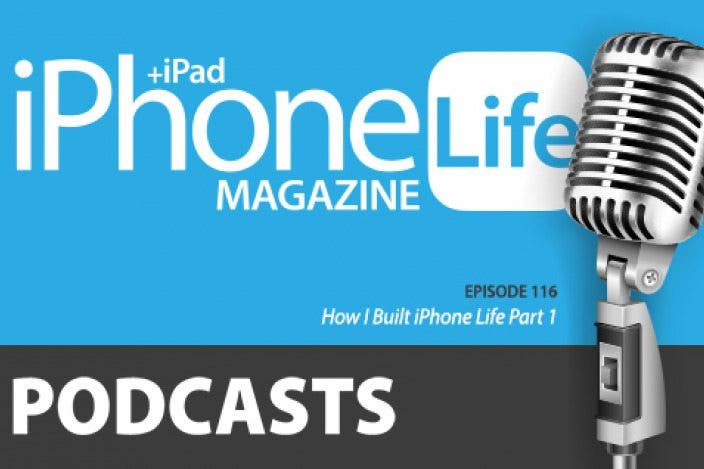
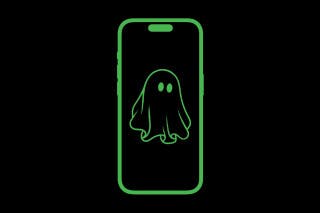
 August Garry
August Garry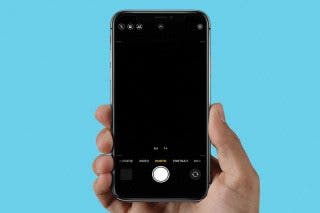
 Rhett Intriago
Rhett Intriago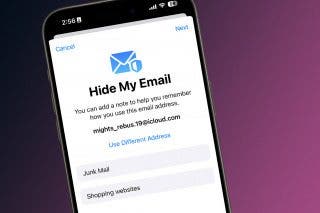
 Rachel Needell
Rachel Needell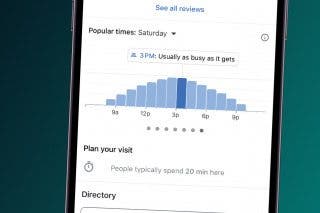

 Olena Kagui
Olena Kagui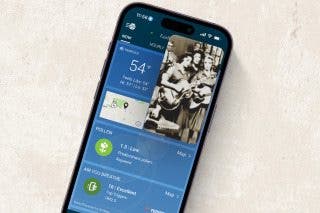
 Amy Spitzfaden Both
Amy Spitzfaden Both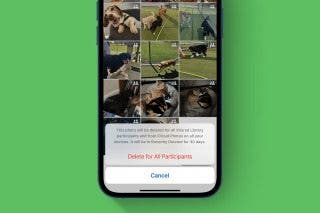
 Brian Peters
Brian Peters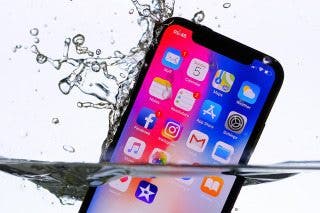
 Leanne Hays
Leanne Hays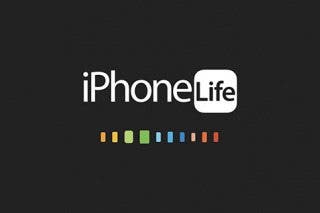
 Susan Misuraca
Susan Misuraca